A review by Maja Ćirić
Exhibitions focused on inherited and newly built infrastructure have carved out a distinct niche in the art world, simultaneously questioning and articulating the intersections of art, technology, and science in relation to power and global politics. Most of them reveal a broader context, extending beyond the limitations of the human scale of time and space, while offering a critical perspective on the bigger picture.
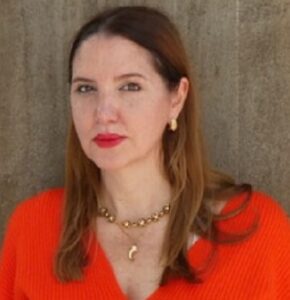
Despite its small size, Luxembourg plays a significant and unique geopolitical role, particularly within Europe and the broader international community. It is also positioning itself as a leader in innovation, especially in sectors like space technology, digitalization, and green finance. Adding to this, the terraforming (1) – conscious zone of visibility created by Elektron in Esch-sur-Alzette serves as a unique platform at the intersection of art, digital technology, science, and society. Led by Françoise Poos as Artistic and Scientific Director, and Vincent Crapon as Curator, Elektron is making substantial strides in illuminating the impacts of planetary computation—a concept referring to the growing interconnection and shaping of our planet by computational processes and digital infrastructures.
Through Cyber Structures: Material Realities–Digital Experiences, curated by Poos and Crapon as a series of seven meticulously conceptualized exhibition projects and artworks, most of them running through October, Elektron has crafted an urban itinerary that thoughtfully explores and highlights the complex and far-reaching effects of computational processes on our planet. Each project not only showcases the intricate relationships between digital technology and the environment but also engages the public in critical discussions about the future of our interconnected world.
Cyber Structures: Material Realities–Digital Experiences unfolds throughout Esch-sur-Alzette as an urban itinerary, circulating around its own infrastructure, extending through Konschthal Esch, Bridderhaus, and the public spaces in between. The project engages with the material realities of the First Industrial Revolution, reflected in the local heritage of iron and steel production, while also exploring the cyber structures of the Third (Digital) Industrial Revolution, which span the globe.
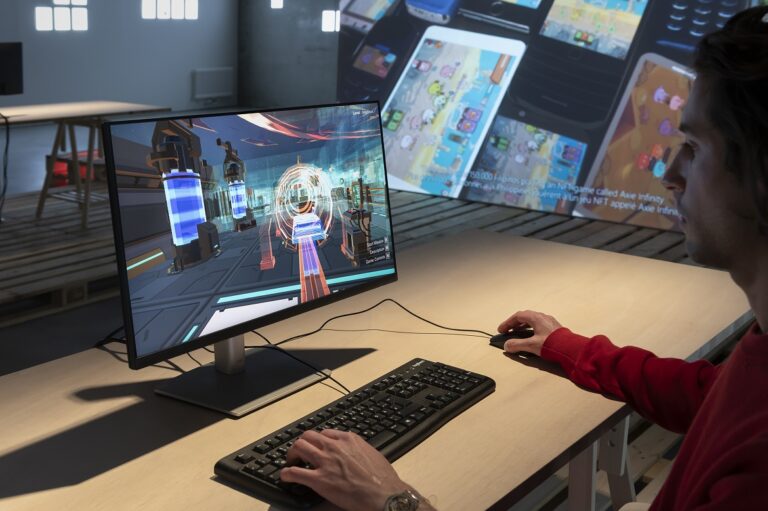
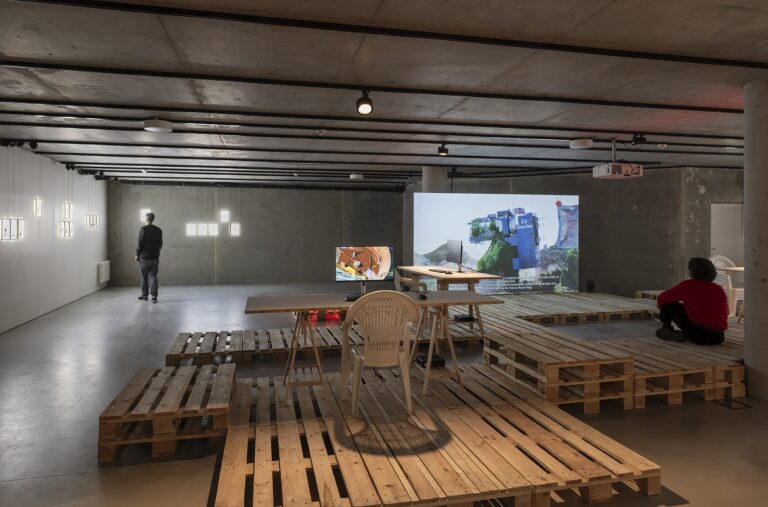
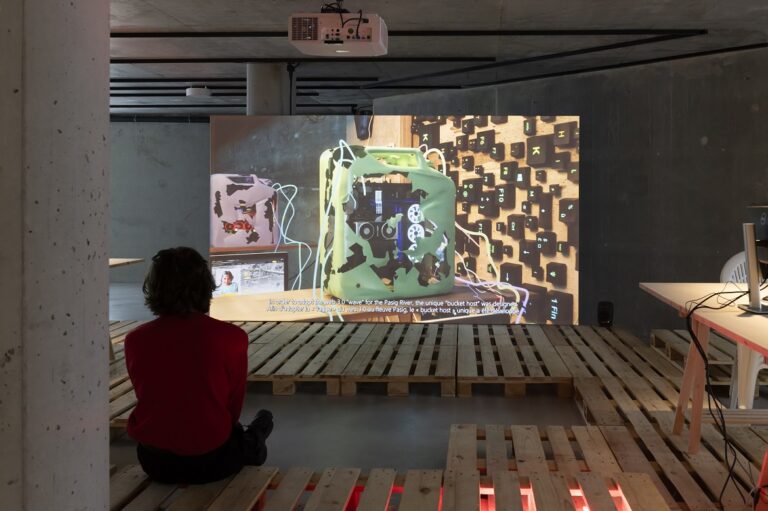
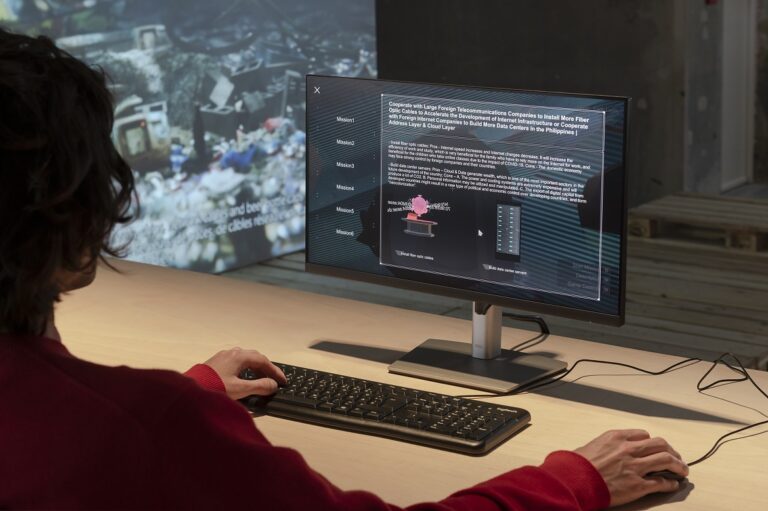
In Konschthal Esch, one of two exhibitions FUTURE_FORECAST by Ziyang Wu + Mark Ramos explores the interplay between power, global politics, and digital technology, emphasizing how the infrastructure behind the Internet—such as undersea cables, data centers, and satellites—mirrors broader political, economic, and ecological dynamics.
In FUTURE_FORECAST, exhibited in Europe for the first time, Ziyang Wu and Mark Ramos examine these themes from a non-Western perspective, focusing on the Philippines as a case study. The works critique how technological development and digital infrastructures can lead to new forms of digital colonialism, where emerging markets and traditional cultures become subject to the influence of powerful global entities. The video Pasig River 2030 – 6 Plus captures the contradictions inherent in technological “progress,” depicting a future where efforts to rejuvenate a polluted river are accompanied by increased surveillance and control, exposing the gap between corporate digital strategies and the realities they impose.
The Future_Forecast semi-speculative simulation further unpacks these issues, inviting players to navigate a world inspired by Benjamin H. Bratton’s Stack theory (2), where our interconnected reality is layered across six strata: Earth, Cloud, City, Address, Interface, and User. The game prompts players to engage with the ecological, geopolitical, and cultural consequences of digital technology, highlighting how these layers, driven by powerful interests, can exacerbate global inequalities and environmental harm. By interacting with this stack, players confront the complexities of our digital world, revealing how deeply embedded technology is within the structures of power and global politics.
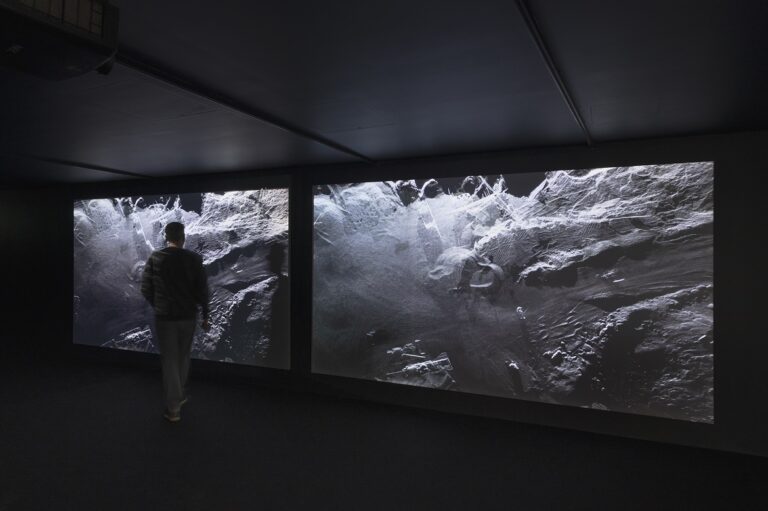
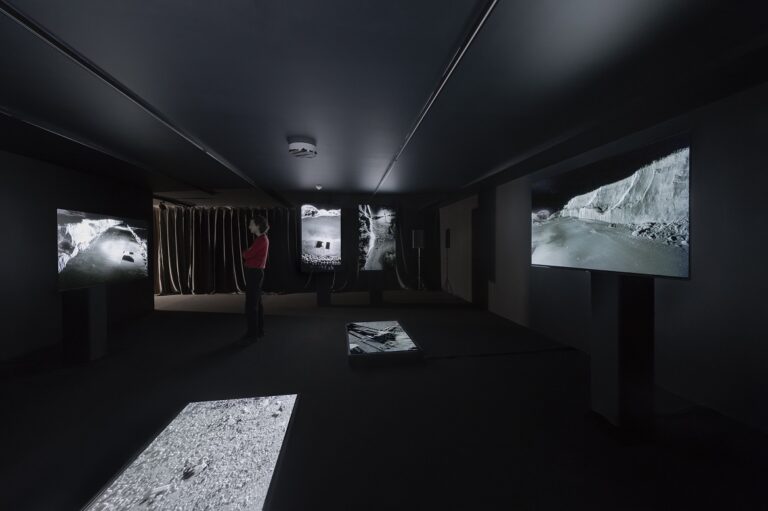
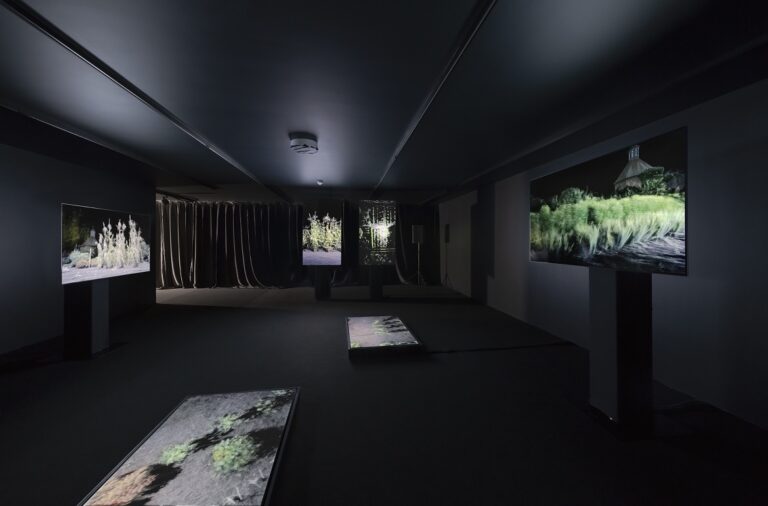
The other exhibition at Konschthal Esch, FRAMERATE: Pulse of the Earth by ScanLAB Projects, explores the intersection of advanced 3D scanning technology with issues of power, surveillance, and geopolitics.
By presenting the forces of nature visible by condensing time through the lens of art and technology, the exhibition reveals how these technologies not only capture but also shape our understanding of the world, raising critical questions about who has access and who controls the narratives that emerge from such data.
It shifts perspectives from centers of power to the consumers, providing a lens through which the ever-changing landscapes are observed. FRAMERATE invites viewers to contemplate change on geological, seasonal, and tidal timescales, thus influencing how societies address long-term environmental and geopolitical challenges.
While the rapid transformations in the scanned landscape points to temporary moments in spaces that may appear hypnotic, poetic and captivating, this technological surveillance ultimately reinforces existing power structures and influences geopolitical strategies concerning resource management and environmental conservation. The ability to document environmental changes on an unprecedented scale reflects a significant power dynamic: those who control such technology gain crucial insights and influence over landscape management and policy-making.
ScanLAB Projects’ https://scanlabprojects.co.uk/ global collaborations further illustrate the international impact of their work on architecture, environmental science, and art. Overall, their work demonstrates how technological advancements can reflect and shape power structures in relation to the Earth dynamics, environmental policies, and global interactions, emphasizing the significant role of technology in contemporary geopolitics.
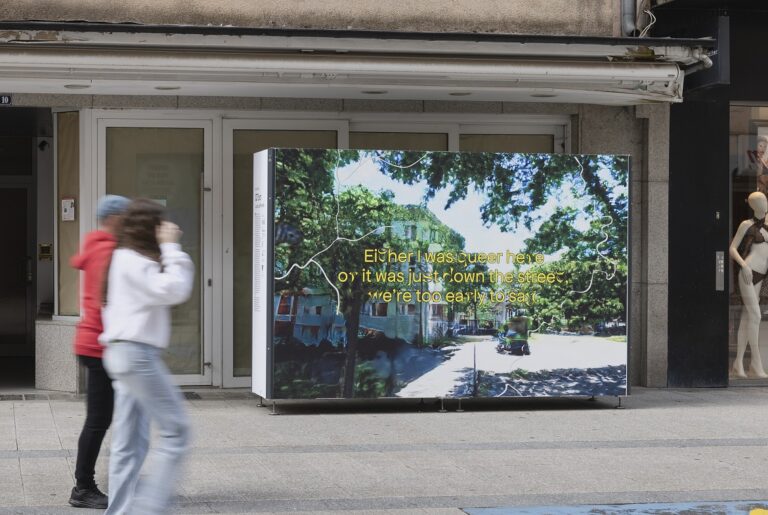
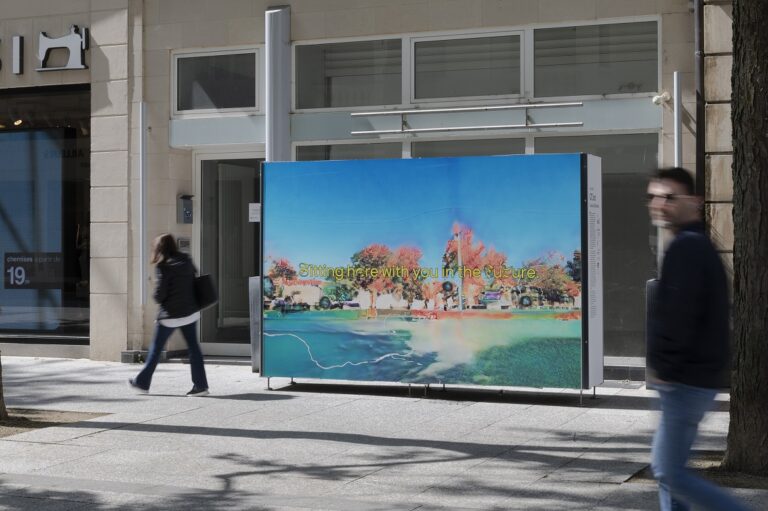
Emerging from the digital mapping platform Queering the Map, established by artist and researcher Lucas LaRochelle, analog panels featuring large-scale prints are positioned throughout the pedestrian streets of Esch-sur-Alzette, with input from QT.bot, an artificial intelligence, trained on the textual and visual data of this queer community mapping platform. By mapping queer experiences globally, the project challenges dominant narratives and highlights the diverse and often marginalized experiences of queer individuals in different geopolitical contexts.
These project in Luxembourg came to being out of a combination with the QT.bot whose digital mind is constructed from an implementation of the Open AI GPT-2 text generation model trained on over 82 000 text entries from the platform, and a StyleGAN trained on scraped Google Street View imagery of the tagged coordinates on Queering the Map. Panels, emerging from LGBTQ2IA+ community generated data, stand for the QT.bot propaganda of disorientation in a way that by integrating this projects the curators allowed for the time, space, norms, hierarchy and subjectivity to be represented as deconstructed in the public sphere.
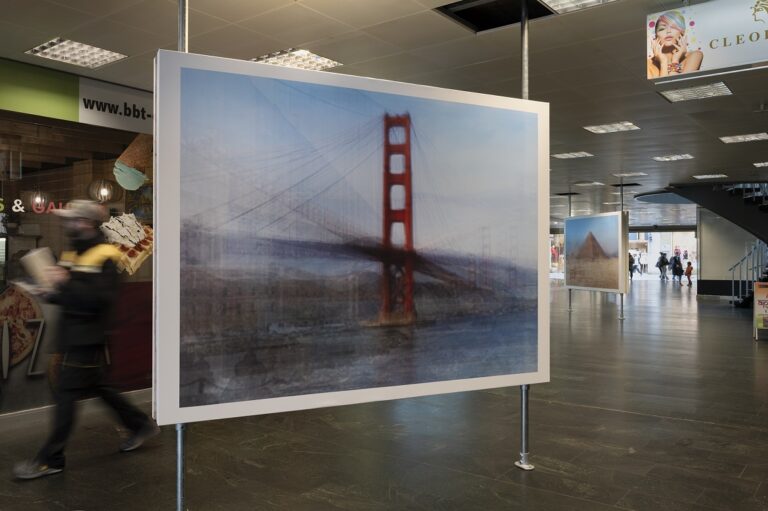
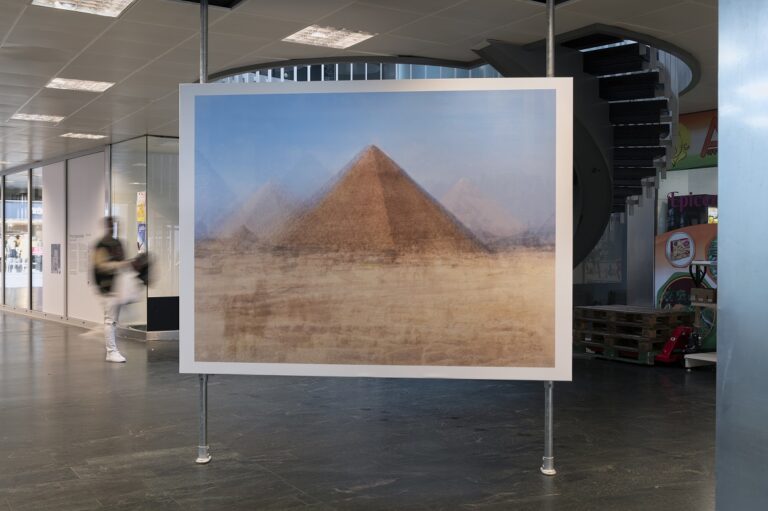
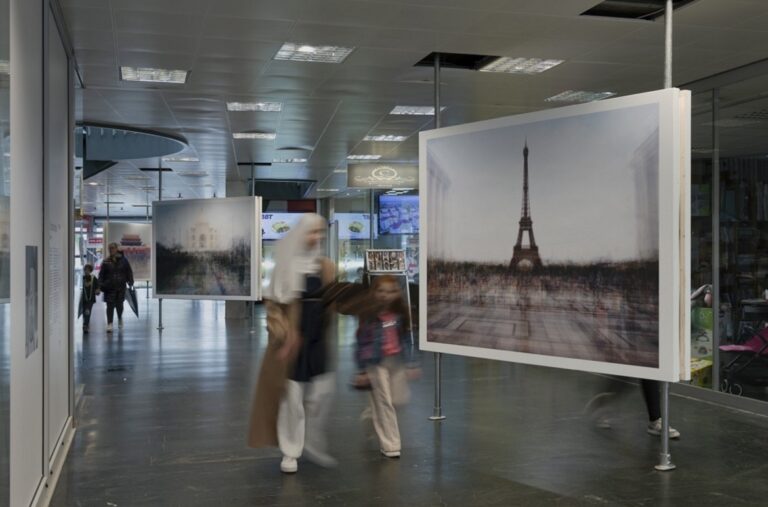
Another context-responsive curatorial approach is manifested in placing Corinne Vionnet’s Photo Opportunities series within a multicultural mini shopping mall. By positioning iconic landmarks such as the Pyramids or the Eiffel Tower in a space typically associated with everyday activities—like purchasing oriental spices or getting a haircut—the installation makes a critical political statement. The stark contrast between the grandeur of these landmarks and the mundane nature of daily routines underscores the repetitive nature of both our daily tasks and the way we photograph these famous sites.
Vionnet’s method involves collecting hundreds of similar photos of these landmarks from the internet, then combining and layering them to create new, intricate artworks. This process reveals how our images of well-known landmarks often conform to established visual clichés, thus exposing a repetitive pattern in how we perceive and capture these iconic places. By placing her work in such a contrasting setting, Vionnet’s installation challenges viewers to reflect on the routine aspects of both our everyday lives and our approaches to capturing global icons.
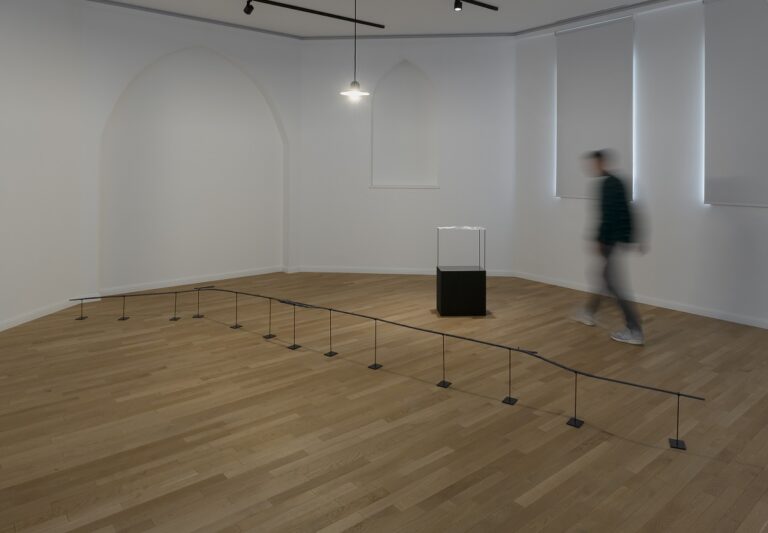
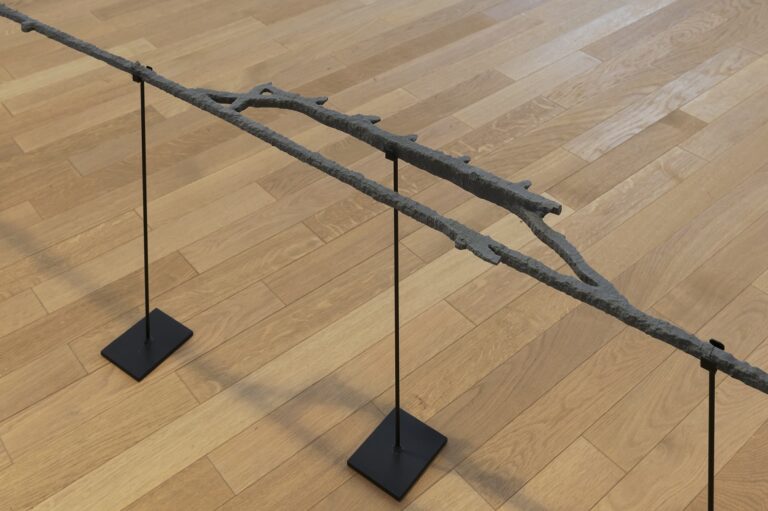
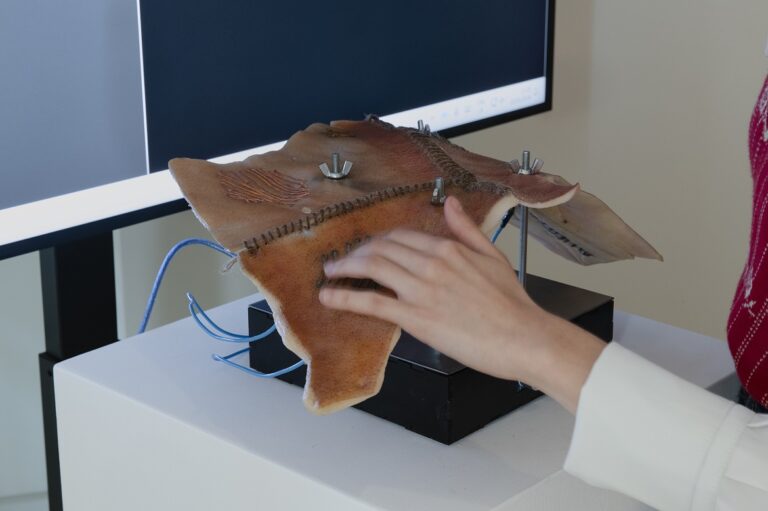
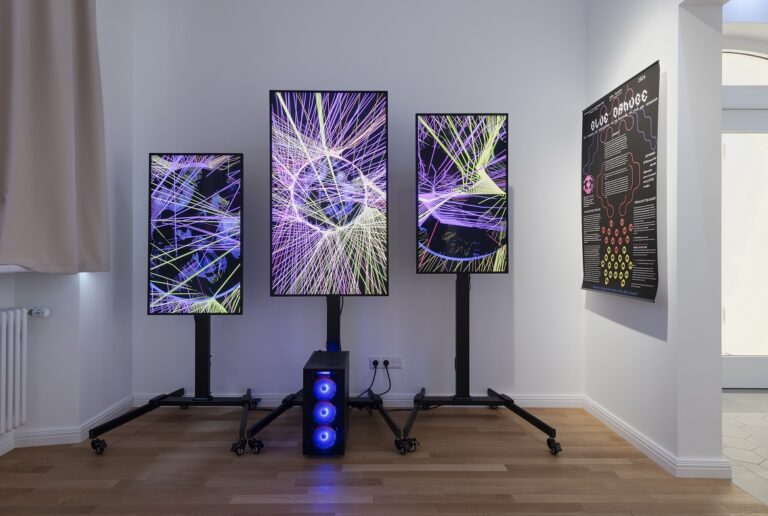
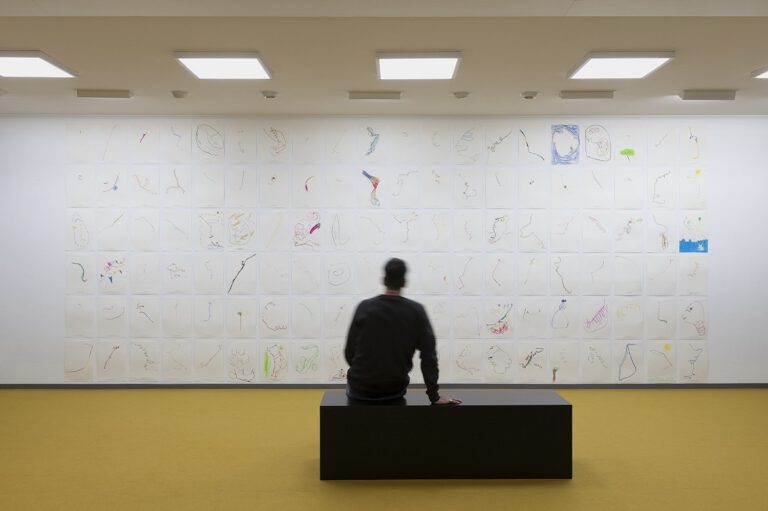
Paying tribute to Luxembourg’s mining legacy, the vast, now-closed network of tunnels would remain largely invisible were it not for artist Serge Ecker. His installation Passages centers on the ARBED tunnel, a 1,800-meter stretch between Rumelange (Laangegronn) and Esch-sur-Alzette (Burbacherlach). Once a vital ore transport route, the tunnel later housed an analog TV antenna cable before being abandoned with the shift to digital technology. Its history mirrors the successive waves of industrial revolutions, each bringing advancements that rendered previous technologies obsolete.
Ecker’s use of 3D scanning technology brings this historic tunnel to life, capturing its intricate structure and transforming it into a sculptural form now displayed at the Bridderhaus. Passages is not merely an empty tunnel but rather the materialization of its emptiness, embodying the void left behind by its former functions. The lamp displayed in the space is an authentic artifact, directly taken from the tunnel, further grounding the installation in the physical reality of the site. Through his work, Ecker not only revives the tunnel’s physical presence but also evokes the layered history of industrial revolutions, emphasizing the cycles of innovation and redundancy that have shaped this site. Ultimately, Passages is not just an artistic exploration but a geopolitical commentary on the economic, cultural, technological, and environmental shifts that have shaped—and continue to shape—the region and its global significance.
In another section of the Bridderhouse, Datamorphosis a sort of beehive presenting the first experiments, prototypes and discussions around the Critical data inherent to other art+science+tech projects by six students of the Interface Cultures Master Linz Künstuniversität – Salma Aly, Alex Fallica, Simon Hehl, Martina Pizzigoni, Sofia Talanti, Emma Silvana Tripaldi. Data and coding, come in lieu of paint and clay, for the digital natives.
Cyber Structures: Material Realities – Digital Experiences is a unique cross-structural endeavor that helps us perceive the invisible power within the technological landscape. As humanity navigates technological advancements and subsequent transformations, there is a cognitive effort required to fully grasp and accept them. Well-thought projects like this showcase not only new methods of inquiry and technology but also emerging epistemologies, bringing people closer to altering the ways they perceive and understand planetary-scale computation in relation to infrastructure.
Notes:
1 – Terraforming (Benjamin H. Bratton,”The Terraforming”, Moscow, Strelka Press, 2019): In Bratton’s work, terraforming is not just about altering other planets but understanding how human activities are reshaping Earth’s landscapes on a planetary scale, demanding new ways of thinking about global environments.
2 – Bratton, Benjamin H.”The Stack: On Software and Sovereignty”. Cambridge, MA: MIT Press, 2016.
Author: Maja Ćirić, PhD – Independent curator and art critic. Maja has received the ISCP Curator Award, the Dedalus Foundation Curatorial Research Award, the Lazar Trifunović Award, the ArtsLink Independent Projects Award, and the Visual Artists Ireland Curatorial Research Award. She served as the curator of the Serbian Pavilion at the Venice Biennale in 2007 and as the commissioner in 2013. She also curated the BJCEM Mediterranea Young Artist Biennale in Tirana, Albania, in 2017, and the 20th Pančevo Art Biennale in Pančevo, Serbia, in 2022.
Maja has been a guest lecturer at the Fine Arts Academy of China, Hangzhou, China; the Faculty of Fine Arts and the Faculty of Architecture at the University of Arts, Belgrade, Serbia; the Faculty of Philosophy at the University of Belgrade, Serbia; Independent Curators International, New York; European University Cyprus, and many official and unofficial curatorial and art-related workshops and mentorship programs.







